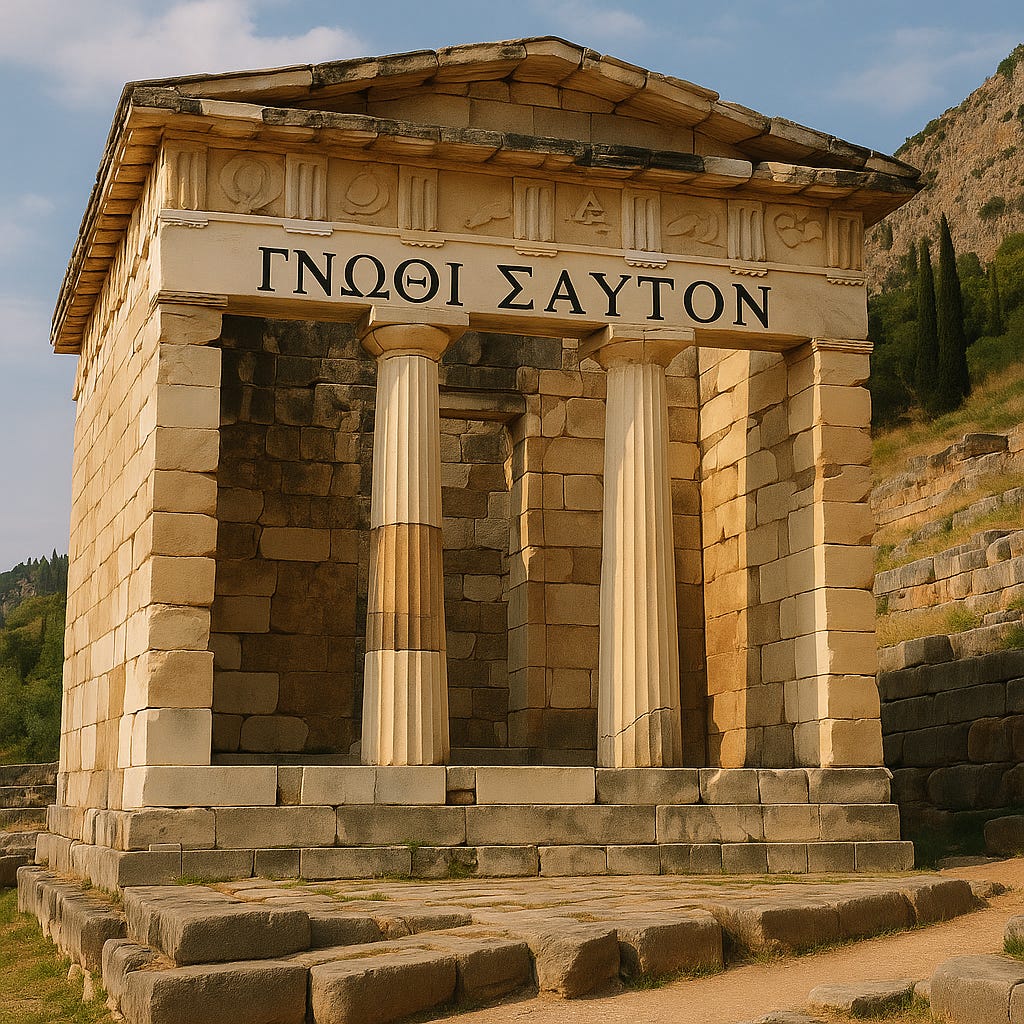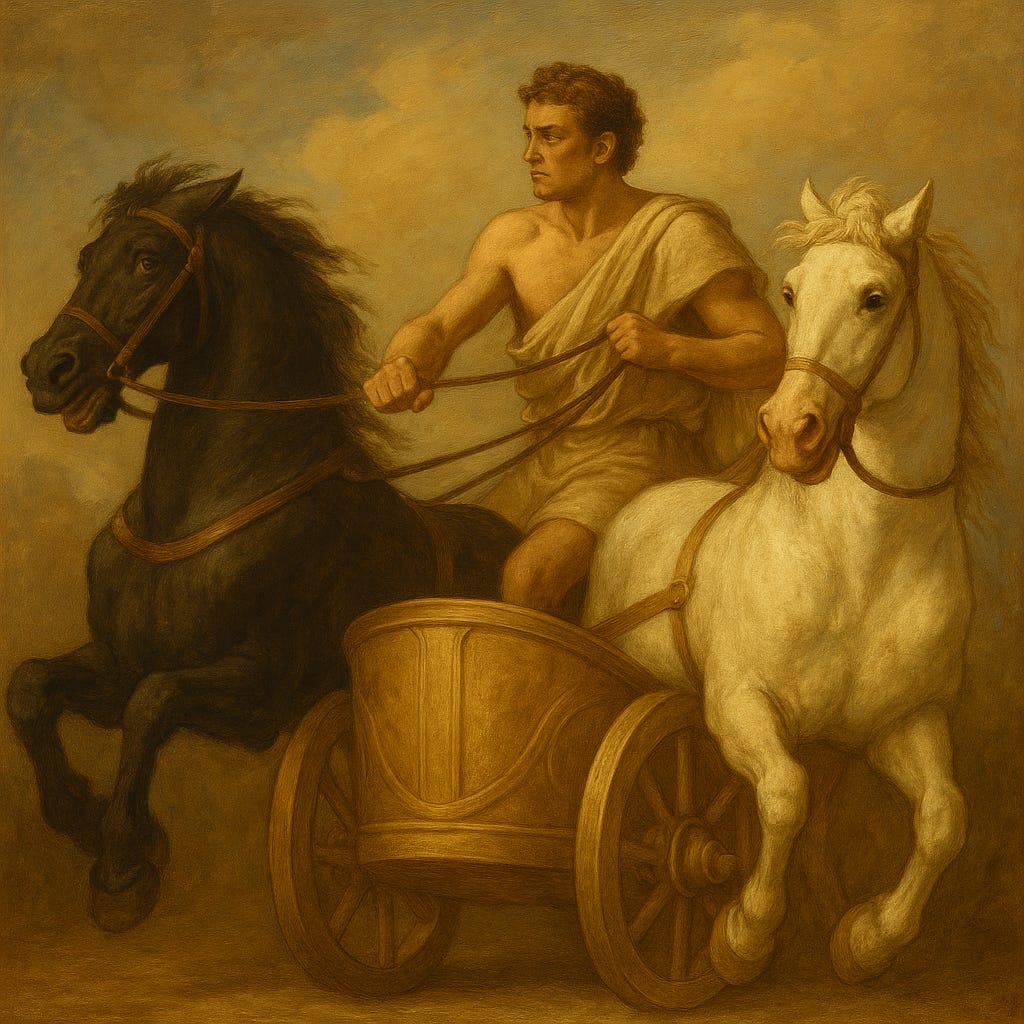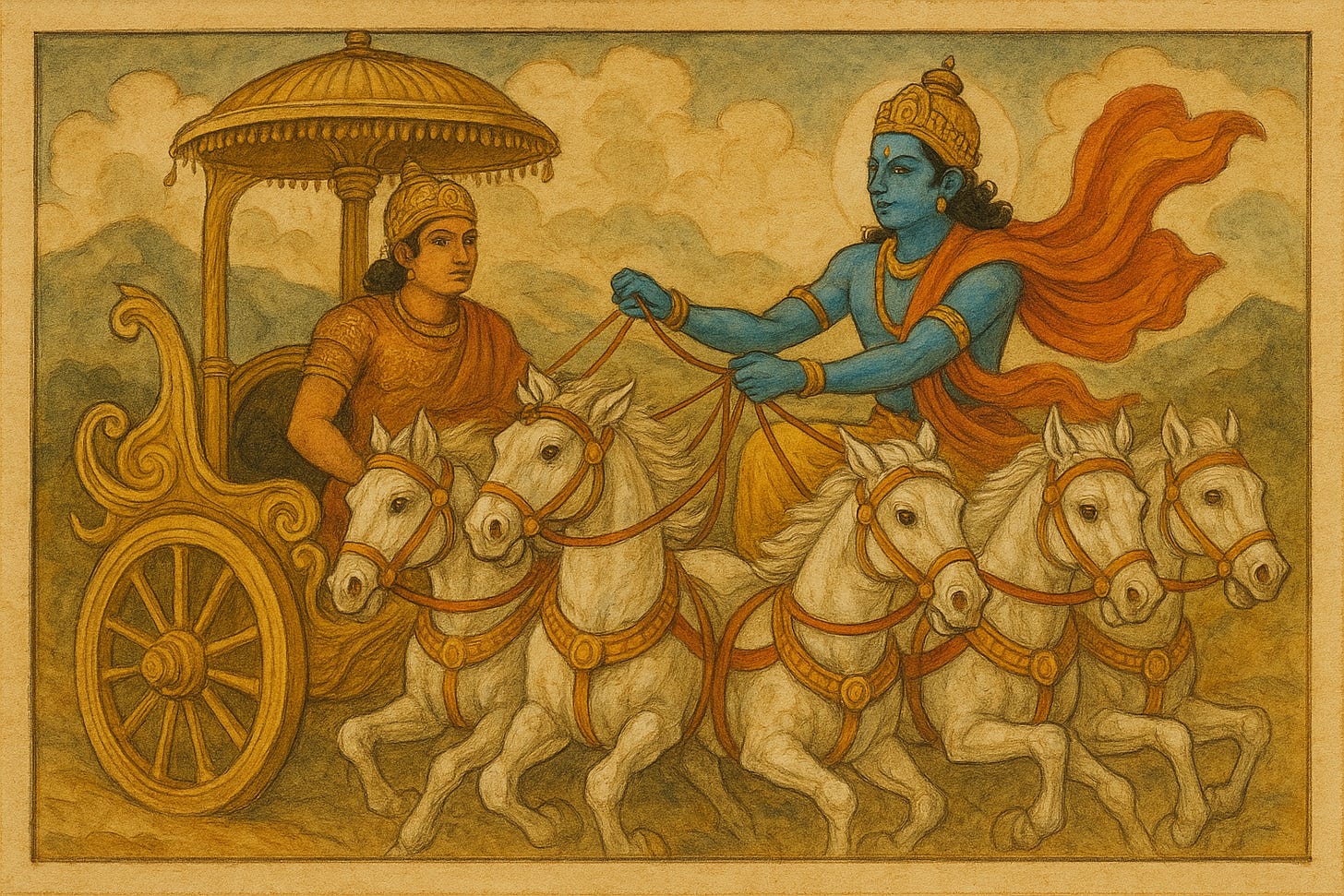Reframing the Relational Self
From the temple stones of Delphi to the whispered prayers of Jerusalem, humanity has long asked:
Who am I?
But perhaps an even deeper question lies underneath:
To whom do I belong?
Our obsession with self-discovery inevitably can define our identity falsely.
Aspects of false identity include but are not limited to performance, appearance, desires, trauma, and isolation.
I. “Know Thyself” The Greek Call to Introspection
At the Temple of Apollo in Delphi, the phrase gnōthi seauton “Know Thyself” was etched above the entrance. The starting point is the self, perceived through an interface with the external world by sensation, incorporation, categorization, dissemination, ultimately to circumvent pride.
For Plato, this introspection revealed the soul’s (the essence of the living being’s) structure. In his chariot allegory (Phaedrus), the self is a rider steering two horses:
One noble (reason and will)
One unruly (desire and appetite)
The charioteer represents the rational mind striving to keep both in balance and ascend to the realm of the divine and the link with what is immortal. A propensity to deign the tangible and flawed physical universe and obsess about that which is eternal and unattainable in the setting of entropy, decay, and death….
II. Arjuna, Krishna, and the Bhagavad Gita: Hindu Reflections on the Self
In the Bhagavad Gita, the chariot reappears this time in the battlefield of the soul.
Arjuna is the warrior, torn by duty and emotion.
Krishna, his divine charioteer, instructs him: true selfhood lies not in detachment, nor in self-will, but in union with the divine through surrender.
The five horses pulling the chariot symbolize the senses. Without a steady charioteer (the intellect), the soul is dragged into chaos. The message: mastery of the self begins with divine alignment. This alignment in a similar manner to Plato’s chariot can subvert that which is tangible and negate the reality of death, decay, and entropy as illusion and not reality…
III. Freud’s Id, Ego, and Superego: A Modern Reframing
Freud’s triadic model mirrors the ancient images:
The id craves,
The superego moralizes,
The ego arbitrates between them.
But Freud’s system lacks transcendence. The self remains closed in on itself, looping between desire and inhibition.
Abraham Joshua Heschel brilliantly captures this as he writes:
“Standing between nothingness and eternity, we are dimly aware of our ineffable situation.” God in Search of Man
This is the soul at its limit the self bound in its own loop, circling endlessly between knowledge of the ineffable infinite and paralysis due to the inability to obtain this in truth. It sees the good, even longs for it, but cannot do it. It knows the abyss and stands at the edge. This is the precipice where the modern self teeters, unable to save itself, unable to turn away.
There is no charioteer beyond the self no divine Krishna, no transcendent goal. This structure alone leads, as Kierkegaard might say, to despair.
IV. Kierkegaard: Despair and the Self Before God
Kierkegaard writes in The Sickness Unto Death that the self is…..
“a relation that relates itself to itself and in relating itself to itself relates itself to another.”
The sickness of the soul is to be out of right relation to refuse to be what one is before God.
Despair, then, is not merely depression or self-hate. It is defiance. It is to say :
“I am my own,” instead of “I am Thine.”
V. Lewis and the Veiled Self: Till We Have Faces
In Till We Have Faces, C.S. Lewis retells the myth of Cupid and Psyche through the voice of Orual, a queen who masks her face and her pain literally and figuratively. Her lifelong demand for answers from the gods finally leads to a revelation not of answers, but of herself:
“I know now, Lord, why you utter no answer. You are yourself the answer. Before your face questions die away. What other answer would suffice?”
Her veil was not just cloth it was the illusion of self-sufficiency. And when she finally sees her own face, she sees the truth: her need, her longing, her love, and the divine face she had always misinterpreted.
Lewis writes:
“How can the gods meet us face to face till we have faces?”
This is not mere psychological wholeness. It is theological encounter. Like Kierkegaard’s despair, Orual’s veiled self cannot relate rightly until it is unveiled not just to herself, but to God.
This is the same cry Paul utters not for knowledge, but for rescue. Not for understanding, but for communion.
Her complaint was not about the gods. It was about herself. She had loved badly, seen wrongly, and hidden from the truth.
In a final vision, Orual sees herself as she really is….veils are removed, and her soul is laid bare before the divine.
“I know now, Lord, why you utter no answer. You are yourself the answer. Before your face questions die away. What other answer would suffice?”
VI. Paul’s Cry and the Spirit’s Answer – Romans 7 and 8
Paul cries in Romans 7:
“Who will rescue me from this body of death?”
Like Arjuna and Freud’s ego Paul stands at the limit of striving.
He sees the good and strived to be good yet he acknowledges that he cannot.
Not by will power or self-knowledge.
Despair rather than defeat reveals the Truth That identity cannot be earned:
It is given identity by adoption
It is answered not by more striving, nor by introspection, but by the voice of the Spirit:
“There is therefore now no condemnation for those who are in Christ Jesus. For the law of the Spirit of life has set you free in Christ Jesus from the law of sin and death.” Romans 8:1–2
And not just rescue, but relationship:
“For you did not receive a spirit of slavery to fall back into fear, but you received the Spirit of adoption, by whom we cry, ‘Abba! Father!’” Romans 8:15
This is the healing of the loop. The self is no longer closed upon itself, spiraling between desire and failure.
Opened and completed, rooted not in performance, but in belonging. Not in self-definition, but in becoming children and heirs.
And so the first words Jesus speaks after His resurrection are not to the crowds, not to Caesar, not even to Peter but to Mary. A woman weeping outside the tomb.
And what He says is the key to everything:
“Go to My brothers and say to them, ‘I am ascending to My Father and your Father, to My God and your God.’” John 20:17
This is the great unveiling: that the Father of Jesus has become our Father. That the relational life Jesus lived from eternity is now shared with us through the Spirit. The loop is no longer self-bound. It is opened, embraced, and drawn upward into communion.
VII. “Know Before Whom You Stand” The Jewish Vision of Relational Reverence
In many synagogues, the phrase “Da lifnei mi atah omed” “Know before whom you stand” is displayed above the ark. This is in contrast to the Temple of Apollo. Here we are beginning with God. Interestingly both ontological presuppositions are to help curb pride. When Jesus was asked to teach prayer He began with “Our Father”.
In this statement there is an element of knowing myself and knowing before whom I stand. This synergy is important and a gateway to everything…. But the key is the Truth in our identity in Christ. Knowing who I am in Christ and Knowing that I stand before loving Father are very different than basing my identity on some preconceived notion of perfection and deities that are capricious.
Yarmulke: Fear of the King, Face to Face
The word yarmulke is thought to derive from the Aramaic or Slavic phrase “yarei malka” literally, “fear of the King.” But this is no cringing fear. In Hebrew, yir’ah (יִרְאָה) springs from the root י-ר-א, meaning to see, to revere, to stand in awe.
The yarmulke, then, is not just fabric. It is theology.
A symbol that we live our lives beneath the gaze of God not self-defined, but always in relation.
It whispers the words seen above the ark in many synagogues:
“Da lifnei mi atah omed”
“Know before whom you stand.”
The yarmulke marks the head the seat of will, intellect, and pride as not supreme, but submitted. It reminds the wearer that identity is not constructed in isolation, but revealed in encounter. Knowing that we stand always before a loving Father is profoundly beautiful. The sanctification of His name through our actions in this world are an honor. His love is so great that all our being responds with gratitude as we are because He is.
And in the finished work of Christ, this reverence is fulfilled in relationship.
Jesus admonished us:
“God is Spirit, and those who worship Him must worship in Spirit and Truth.”John 4:24
Through Christ finished work, the veil is torn…both the veil of the Temple and the veil of His body. Now, the way is open.
As the epistle to the Hebrews says:
“We have confidence to enter the Most Holy Place by the blood of Jesus, by a new and living way opened for us through the curtain, that is, His body.”Hebrews 10:19–20 (NIV)
We worship not from a distance, but boldly, in Spirit and in Truth.
The fear of the King becomes the joy of the child.
“I ascend to My Father and your Father, to My God and your God.” John 20:17
IX. From Fig Leaves to Full Communion: The Gospel and the Relational Self
In the beginning, the self was not hidden.
“The man and his wife were both naked, and they felt no shame.”Genesis 2:25
But when trust was broken—when the self turned inward and grasped for control everything fractured. Nakedness became exposure. Intimacy became fear. They sewed fig leaves and hid from the presence of the Lord.
“Where are you?” Genesis 3:9
That question still echoes in every fragmented soul.
The relational self, once whole, became veiled by shame and self-justification. Philosophies offered insight. Religions offered laws. Psychology offered mirrors. But none could remove the veil.
Only Christ goes to the root.
He bore our shame naked, exposed, and alone so we might be clothed in His righteousness. In His death, the veil was torn. In His resurrection, the invitation returned:
“Go to My brothers and say to them, ‘I ascend to My Father and your Father…’” John 20:17
Now, in Him, we do not approach in fear. We approach as sons and daughters, fully known and fully loved.
“Now we see as through a mirror, dimly…”“But then….face to face.”1Corinthians 13:12








